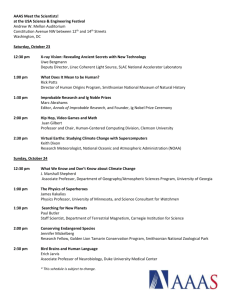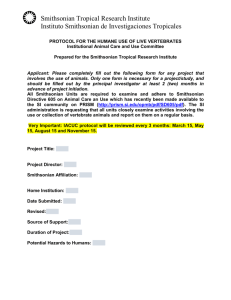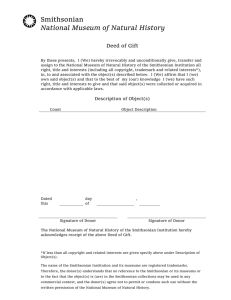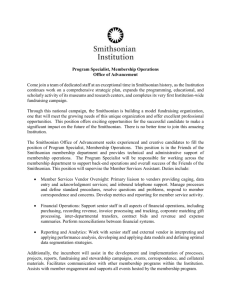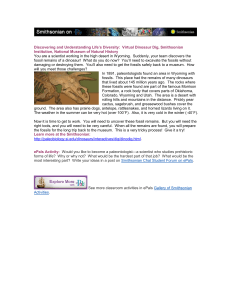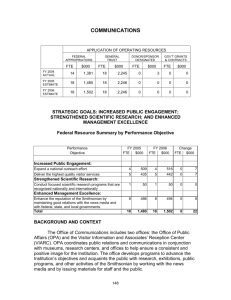Audit of Management of the Government Purchase Card Program
advertisement
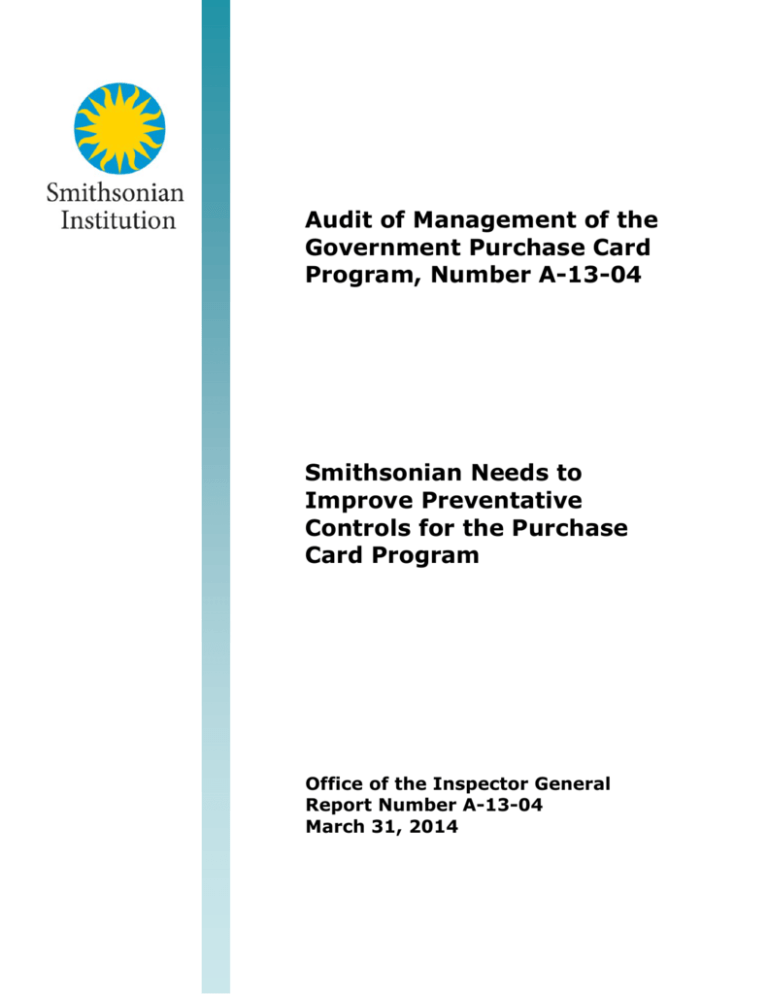
Audit of Management of the Government Purchase Card Program, Number A-13-04 Smithsonian Needs to Improve Preventative Controls for the Purchase Card Program Office of the Inspector General Report Number A-13-04 March 31, 2014 Smithsonian Institution Office of the Inspector General In Brief Smithsonian Needs to Improve Preventative Controls for the Purchase Card Program, Report Number A-13-04, March 31, 2014 Why We Did This Audit What We Found The Smithsonian management has a heightened interest in reducing the risk of misuse, fraud, waste, and abuse in such vulnerable areas as cash processing and purchasing. Purchase cards allow the same individual to order, pay for, and receive goods and services. If purchase card internal controls are not properly designed, it will be difficult for management to detect and prevent fraudulent purchases or improper uses of the cards. We found that the Smithsonian generally exercised effective management and oversight of the Smithsonian Purchase Card Program. In general, the purchase card transactions we reviewed were appropriate for the mission of the purchasing unit. However, we determined that some additional preventative controls could improve the program. Our audit objective was to determine if the Smithsonian exercises effective management and oversight of the government purchase card program. Background The Smithsonian uses purchase cards to reduce the administrative cost of small dollar purchases, incurring over $27 million in expenditures for 100,498 transactions from October 1, 2011 through December 31, 2012. At the end of 2012, there were 658 open purchase card accounts issued to Smithsonian personnel. We found that approving officials were not always approving purchase card transactions in the Smithsonian’s financial system or documenting their review of cardholder purchase logs and credit card statements as required by Smithsonian policies and procedures. We also found that the management had not blocked Merchant Category Codes that allow certain high-risk transactions, such as purchases of jewelry, watches, furs, and alcohol. In addition, Smithsonian had not fully implemented best practices to ensure effective strategic sourcing when employees use government purchase cards to acquire commonly purchased goods and services. Lastly, we found that the Smithsonian may have inappropriately paid state and local sales taxes on purchase card transactions. What We Recommended To strengthen the Purchase Card Program, we recommended that management: reinforce the need for approving officials to timely approve transactions in the Smithsonian’s financial system; evaluate restrictions on Merchant Category Codes; develop and implement a strategic sourcing program that encompasses all procurement methods, including purchase card transactions; develop thresholds for recovering erroneous tax payments. Management generally concurred with our findings and recommendations and has planned corrective actions to address the recommendations. We will continue to monitor management’s progress towards completion of these recommendations. For additional information or a copy of the full report, contact the Office of the Inspector General at (202) 633-7050 or visit http://www.si.edu/oig. SMITHSONIAN INSTITUTION OFFICE OF THE INSPECTOR GENERAL INTRODUCTION This report presents the results of our audit of the Smithsonian’s Purchase Card Program. The objective of the audit was to determine if the Smithsonian exercises effective management and oversight of the Smithsonian Purchase Card Program. The purpose of the Purchase Card Program is to reduce administrative costs and time for purchasing and paying for goods and services by using purchase cards, a type of charge card. The Smithsonian participates in a government-wide contract with the General Services Administration (GSA) through the Department of Commerce. This contract facilitates the issuance of charge cards for use by agencies in support of their procurement activities. The Smithsonian uses purchase cards that are issued by JPMorgan Chase & Co. (JPMC). In addition to the purchase cards, the Smithsonian also uses travel and fleet cards issued by JPMC. A detailed description of our objectives, scope, and methodology is included in Appendix A. RESULTS IN BRIEF We found that the Smithsonian generally exercised effective management and oversight of the Smithsonian Purchase Card Program. The Smithsonian had implemented policies and procedures that provided sufficient guidance and adequate oversight over purchase card activity. We found that, in general, the transactions we reviewed were appropriate for the mission of the purchasing unit. However, we determined a need to strengthen controls in the following areas: (1) oversight of approving officials; (2) restrictions on merchant category codes (MCCs); (3) strategic sourcing; and (4) payment of sales tax. Oversight of Approving Officials We found that approving officials were not always approving purchase card transactions in PeopleSoft, increasing the risk of fraud and misuse of Smithsonian funds. Specifically, approving officials did not approve over 2,100 purchase card transactions, amounting to approximately $350,000, in PeopleSoft. In addition, of the 84 cardholders and approving officials contacted for purchase card transaction documentation, we saw evidence of approving officials’ reviews on less than half of the documentation provided. To ensure that purchase card transactions are appropriately reviewed, we made two recommendations for OCon&PPM management to reinforce the provisions of Smithsonian Directive (SD) 322, Charge Card Program Desk Reference and Training Manual and to conduct periodic on-site reviews. 1 SMITHSONIAN INSTITUTION OFFICE OF THE INSPECTOR GENERAL Restrictions on Merchant Category Codes The Smithsonian’s Purchase Card Program had not blocked some merchant category codes assigned to higher risk merchants, such as jewelry stores, furriers, and liquor stores. We recommended that OCon&PPM evaluate restrictions on MCCs to identify additional codes that should be blocked to prevent unallowable purchases. Strategic Sourcing The Smithsonian had not fully implemented required practices to ensure effective strategic sourcing when employees use government purchase cards to acquire commonly purchased goods and services. We determined that Smithsonian purchase cardholders spent less than $500,000, or 2 percent of purchase card transactions during the 15-month period, on low-cost strategic sourcing vendors, such as those selected by GSA, to help reduce purchasing costs. We made two recommendations to OCon&PPM management to develop and implement a strategic sourcing program that encompasses all procurement methods, including purchase card transactions, as well as increasing purchase cardholders’ use of strategic sourcing vendors. Sales Tax We found that the Smithsonian may have inappropriately paid state and local taxes on purchase card transactions. According to transaction reports from JPMC’s PaymentNet system, the Smithsonian potentially paid up to $26,000 in state and local taxes for transactions made during the scope of the audit. We also found that the Smithsonian may have potentially paid an additional $77,600 in taxes between fiscal years 2009 through 2011. We recommended that OCon&PPM management develop thresholds for recovering erroneous tax payments and initiate corrective action when necessary. Management generally concurred with our findings and recommendations and has proposed corrective actions that will address the recommendations. Please refer to Appendix B for management’s complete response. BACKGROUND Roles and Responsibilities The Director of the Office of Contracting and Personal Property Management (OCon&PPM) is responsible for overseeing the procurement of goods and services. The Charge Card Program manages Smithsonian-issued purchase, fleet, and travel cards. The Director of OCon&PPM delegates authority and responsibility for the dayto-day management and oversight of the Charge Card Program to the Charge Card Program Manager. The Charge Card Program Manager is responsible for the 2 SMITHSONIAN INSTITUTION OFFICE OF THE INSPECTOR GENERAL Purchase Card Program, which includes: ensuring that initial and refresher training is available for purchase cardholders and approving officials; reviewing purchase card transactions; and conducting on-site reviews to confirm compliance with purchase card program policies and procedures. In addition, the Charge Card Program Manager is responsible for implementing a strategic sourcing plan1 to analyze how purchase cardholders spend funds in order to ensure that the Smithsonian is leveraging its purchasing power. At the unit level, directors, approving officials, and cardholders share responsibility for appropriate purchase card use. Directors are responsible for nominating qualified employees to be purchase cardholders and approving officials in their units. In addition to other oversight responsibilities, approving officials must approve cardholder charges each month in the Smithsonian’s financial system (PeopleSoft) within the time designated by the Charge Card Program Manager. Cardholders must assure that they use the purchase cards properly and only for authorized purposes as defined by Smithsonian purchase card policies and procedures. Cardholders are also responsible for reconciling their purchase card transaction log to the purchase card transactions listed in PeopleSoft within the time designated by the Charge Card Program Manager. Additionally, they must review and sign monthly paper statements received from JPMC and immediately notify JPMC of any billing discrepancies posted on the account. Cardholders are responsible for ensuring purchase card transactions do not include sales tax, as prohibited by Smithsonian purchase card policies and procedures and the Office of Management and Budget (OMB). Preventative Controls The Smithsonian has implemented several preventative controls to minimize the risk of fraudulent, improper, or abusive purchase card use. The Charge Card Program Manager assigns each purchase card a single transaction limit, as well as a monthly purchase limit. Typically, the single transaction limit within the Smithsonian is $3,000. However, there are cardholders who have single transaction limits up to $60,000, depending on the needs of their unit. Cardholders may submit requests to the Charge Card Program Manager to raise their single transaction or monthly purchase limits. The Smithsonian also uses MCCs, which identify the nature of a business, to prevent inappropriate card usage. For example, MCCs can be used to block purchases from merchants that are more likely to be considered improper, such as online dating businesses, jewelry stores, furriers, liquor stores, casinos, and pawn shops. 1 According to the Office of Management and Budget, strategic sourcing is the collaborative and structured process of critically analyzing an organization’s spending and using the information to make business decisions about acquiring certain items more effectively and efficiently. 3 SMITHSONIAN INSTITUTION OFFICE OF THE INSPECTOR GENERAL Volume of Purchase Card Usage During the fifteen-month period we reviewed, from October 1, 2011 through December 31, 2012, Smithsonian purchase cardholders made 100,498 purchases amounting to over $27 million. Since entering into the agreement with JPMC in fiscal year 2008, the Smithsonian has spent an average of $22 million in 86,000 purchase card transactions per year. As of December 31, 2012, the Smithsonian had 658 active purchase card accounts. Number of Transactions Fiscal Years 2008 - 2012 Dollars Spent Fiscal Years 2008 - 2012 100,000 90,000 80,000 70,000 60,000 50,000 40,000 30,000 20,000 10,000 0 25,000,000 20,000,000 15,000,000 10,000,000 5,000,000 0 FY 08 FY 09 FY 10 FY 11 FY 12 FY 08 FY 09 FY 10 FY 11 FY 12 By using purchase cards to pay for transactions during fiscal year 2012, the Smithsonian estimated that it reduced administrative costs associated with purchasing by an average of $503,000 per month. RESULTS OF AUDIT Approving Officials Need to Increase Oversight of Purchase Card Transactions We found that approving officials were not always approving purchase card transactions in PeopleSoft, as required by Smithsonian policies and procedures. We determined that approving officials did not approve over 2,100 of 100,498 purchase card transactions, amounting to over $350,000, in PeopleSoft. Approving officials did not approve transactions for items such as electronics, computer equipment, office supplies, laboratory equipment, and clothing. Moreover, approving officials did not always document their review of cardholder purchase logs and credit card statements, as required by Smithsonian policies and procedures. We contacted 84 cardholders and approving officials for purchase card documentation. We saw evidence of approving officials’ reviews on less than half of the documentation provided. According to SD 322, the Charge Card Program Manager delegates authority for day-to-day management of purchase card activity to approving officials at the 4 SMITHSONIAN INSTITUTION OFFICE OF THE INSPECTOR GENERAL individual units. Smithsonian purchase card policies and procedures require that approving officials: • Conduct monthly reviews of the cardholders’ purchase card transaction logs to ensure that cardholder documentation is adequate and to ensure that the cardholder reconciled the purchase card documentation to the monthly paper statement issued by JPMC; • Approve cardholders’ charges each month in PeopleSoft within the time period designated by the Charge Card Program Manager, generally within two weeks before posted transactions are paid; and • Review and sign the cardholders’ monthly paper statements issued by JPMC. Purchase Card Transaction Approval Process Approving Officials confirm that all purchases were appropriate and made with available funds. Aproving Officials review purchase card logs to ensure adequacy of cardholder documentation and evidence of cardholder reconciliation. Approving Officials ensure that transactions are approved within PeopleSoft. Charge Card Program staff review PeopleSoft reports to determine whether the transactions were approved. Source: Smithsonian Purchase Card Policies and Procedures SD 322 also states that the Charge Card Program Manager conducts on-site reviews to confirm that cardholders and approving officials are in compliance with purchase card policies and procedures. Charge Card Program staff are responsible for monitoring on-line approvals within PeopleSoft and may cancel or suspend purchase cards or revoke approval authority for continued non-compliant approvers. In addition, charge card program management should conduct periodic reviews of cardholder records, as recommended by GSA’s Guide to Best Practices for Purchase and Travel Charge Card Program Management. Approving officials did not provide adequate oversight of cardholders for a number of reasons: • The Smithsonian allowed purchase card transactions to be paid even though approving officials did not verify and approve transactions in PeopleSoft within the allotted time. The Charge Card Program Manager told us that they 5 SMITHSONIAN INSTITUTION OFFICE OF THE INSPECTOR GENERAL accepted the risk of paying for unapproved purchases to ensure the Smithsonian promptly paid its monthly charge card bill. • Approving officials face minimal consequences for not approving transactions in PeopleSoft. The Charge Card Program Manager notifies cardholders and approving officials of monthly deadlines to approve transactions. Every month, he contacts the approving officials who have not approved purchase card transactions in the financial system within the allotted time. Although the Charge Card Program staff identified individuals who repeatedly failed to approve transactions, no action was taken to cancel or suspend purchase card authority for approving officials who frequently did not approve transactions within the allocated time. According to the Charge Card Program Manager, due to time constraints and other priorities, the Program staff did not conduct required on-site reviews to determine whether approving officials were reviewing cardholder transactions. Most of the staff’s oversight of purchase card activity is comprised of their monthly reviews of transaction data from JPMC and not on cardholder documentation. In addition, they contact cardholders regarding questionable transactions and forward potentially fraudulent cases to investigators in the Smithsonian’s Office of the Inspector General and Smithsonian management when necessary. When approving officials are not diligent in their monitoring and approval of purchase card transactions, there is a greater likelihood that cardholders may make inappropriate purchases, potentially resulting in an increased risk of fraud and misuse of Smithsonian funds. As a result, the Charge Card Program staff is forced to spend additional time researching and resolving questionable purchases that should have been addressed by the approving officials at the unit level. Charge Card Program staff could use this time to conduct periodic on-site reviews or research opportunities to leverage the Smithsonian’s purchasing power in order to reduce costs. In addition, the lack of documentation of approving officials’ purchase card reviews, at the unit level, makes it difficult for the Smithsonian Charge Card Program staff to assess compliance with Smithsonian purchase card policy, as well as to determine whether the purchase was appropriate and relevant to the unit’s mission. Recommendations To ensure that purchase card transactions are appropriately reviewed and approved, we recommend that the Director, Office of Contracting and Personal Property Management: 1. Continue to reinforce to Smithsonian units that the provisions of SD 322 require that approving officials approve transactions in the Smithsonian’s financial system within the established timeline. 6 SMITHSONIAN INSTITUTION OFFICE OF THE INSPECTOR GENERAL 2. Conduct periodic on-site reviews to ensure that approving officials review and sign cardholder transaction logs and credit card statements, as required by SD 322, Desk Reference and Training Manual, Section 4.8.5; and, based on the results of these reviews, take appropriate corrective action. Management provided support for completion of recommendation 1. We confirmed that management reinforced to approving officials that transactions must be approved in the Smithsonian’s financial system within the established timeline. We will close this recommendation effective the date of this report. All High-Risk Merchant Category Codes not Blocked Although the sample of purchase card transactions we reviewed did not identify any inappropriate purchases, we found that Smithsonian purchase cardholders made 87 purchases, amounting to approximately $48,000, at 27 jewelry stores, watch and jewelry repair stores, furriers, and liquor stores. We selected a sample of these purchases and found no inappropriate transactions. Although the Charge Card Program has placed restrictions on other high-risk MCCs, by not blocking these specific high-risk MCCs, the Charge Card Program allows all cardholders—not just those who have a legitimate need—to make purchases at these types of merchants. OMB guidance on the management of charge card programs recommends that agencies “block” or restrict purchases with vendors assigned high-risk merchant category codes to mitigate waste, fraud, and abuse. GSA and other agencies’ guidance for charge card programs recommend that certain MCCs, such as those assigned to jewelry and liquor stores, remain blocked to prevent improper purchases. The Smithsonian Charge Card Program Manager has the ability to unblock, or lift, codes to allow transactions for specific purchases to be processed. Although the purchases we reviewed were appropriate, other cardholders are also able to make these types of purchases because the Smithsonian’s Purchase Card Program has not placed blocks on all high-risk MCCs. The Smithsonian Charge Card Program Manager explained that due to the variety of purchases made by Smithsonian cardholders, these particular high-risk MCCs should remain unblocked. According to the Charge Card Program Manager, cardholders may need to purchase items from vendors with these high-risk merchant category codes for a number of reasons. In order to assess the legitimacy of these 87 purchases, we tested a sample of 21 transactions made at these high-risk stores. For each transaction in this sample, we reviewed receipts, purchase card logs, and other supporting documentation. We also discussed the purpose of the purchases with the cardholders or approving officials. We concluded that all of the purchases we sampled were legitimate. For example, a cardholder purchased items from jewelry stores for resale at museumoperated gift shops. In another example, cardholders purchased alcoholic beverages using trust funds for special events at museums, such as exhibit openings—a permissible use of funds in accordance with Smithsonian policy. 7 SMITHSONIAN INSTITUTION OFFICE OF THE INSPECTOR GENERAL Cardholders also purchased beaver fur pelts and other items made from fur for use in exhibits. The Charge Card Program Manager also told us that blocking these codes would create an administrative burden on the staff to constantly review cardholder requests to unblock, or lift, codes to make these purchases. However, we do not believe that responding to requests to lift codes would create a significant amount of additional work for the Charge Card Program staff. For example, during the period from October 2011 through December 2012, there were only 87 purchases from jewelry stores, watch and jewelry repair stores, furriers, and liquor stores—an average of approximately six transactions a month. The Charge Card Program staff also stated that blocking these MCCs is unnecessary because they believe their monthly review of purchase card transactions provides adequate detection of possible purchase card misuse. However, by only reviewing monthly, there is an increased likelihood that an inappropriate transaction may go undetected for several weeks. We believe that by allowing all cardholders to make purchases from merchants with high-risk MCCs, the Smithsonian elevates the potential for cardholder misuse or abuse. Although we found cardholders in our sample had legitimate reasons for making purchases from merchants with high-risk MCCs, we believe the program staff could reduce the risk of improper purchases by imposing some restrictions on particularly high-risk MCCs for all cardholders. Recommendation In order to reduce the risk of improper purchase card transactions, we recommend that the Director, Office of Contracting and Personal Property Management: 3. Evaluate restrictions on particularly high-risk MCCs to identify those that should be blocked to prevent unallowable purchases. Minimize Purchasing Costs through Strategic Sourcing The Smithsonian participates in GSA’s government-wide charge card program. OMB Circular A-123 Appendix B requires agencies to develop and implement policies and practices that ensure effective strategic sourcing through purchase card transactions. Therefore, we believe the Smithsonian should follow the best practices, as set forth in Appendix B. These policies and practices include: • A thorough spend analysis of purchase card data; • A balanced approach considering socio-economic goals and prioritized objectives, if applicable; • Performance measures to assess progress toward achieving agency strategic sourcing goals; 8 SMITHSONIAN INSTITUTION OFFICE OF THE INSPECTOR GENERAL • Establishment of key roles and responsibilities, including identification of the official responsible for achieving agency strategic sourcing goals; • Communication and training strategy; and • Development of internal control mechanisms to ensure agency compliance. The Smithsonian has not fully implemented these best practices to ensure effective strategic sourcing when employees use government purchase cards to acquire commonly purchased goods and services. In line with GSA guidance in OMB Circular A-123 Appendix B, the Smithsonian offers cardholders training on the use of agency-wide contracts and GSA-approved vendors; however, it had not implemented other requirements of a strategic sourcing program. For example, the Smithsonian had not implemented the following practices established by OMB: (1) analyzing purchase card spending data to assess the effectiveness of the strategic sourcing efforts, (2) developing purchase card strategic sourcing goals, (3) identifying an official responsible for achieving strategic sourcing goals, or (4) developing internal control mechanisms to ensure agency compliance. During the audit, we observed that the Smithsonian spent approximately $27 million for purchase card transactions. However, the Smithsonian spent less than $500,000 or 2% of purchase card transactions with vendors approved by GSA to help federal agencies reduce purchasing costs. The Smithsonian is not actively utilizing strategic sourcing as it relates to purchase card spending because: • The Smithsonian Charge Card Program has not fully implemented a comprehensive approach to strategic sourcing which should establish agency strategic sourcing goals and performance measures for purchase cards, as encouraged by OMB. For example, OCon&PPM staff were not required to analyze purchase card spending data to ensure that units were using strategic sourcing for purchase card transactions to leverage the Smithsonian’s purchasing power and reduce costs, as recommended by OMB. • Although the Charge Card Program provides approving officials and cardholders with information about the strategic sourcing opportunities through its directive, training, and website, cardholders are permitted to purchase from any vendor they prefer. For example, cardholders can purchase from vendors other than those selected by GSA or the Smithsonian. Furthermore, the Charge Card Program Manager informed us that some cardholders do not use GSA-identified vendors because they have been able to independently negotiate lower prices. Failure to conduct spending data analysis related to purchase card purchases prevents the Smithsonian from identifying opportunities to further reduce the costs of purchase card transactions. This is especially important in the current environment of reduced federal appropriations. The Smithsonian Purchase Card 9 SMITHSONIAN INSTITUTION OFFICE OF THE INSPECTOR GENERAL Program is not taking greater advantage of multi-agency wide contracts that could result in better pricing and lower costs for purchase card transactions. From October 2011 through December 2012, the Smithsonian spent approximately $1,253,000 on office supplies. In December 2011, GSA reported that federal agencies estimated cost savings from strategic sourcing ranged from 6 to 20 percent on their purchases of routine office supplies. While some cardholders may have purchased office supplies from low-cost vendors, to estimate the potential for savings, we applied the GSA cost saving percentages to the amount spent on office supplies. Based upon our calculations, we estimate that the Smithsonian could have realized savings of up to $251,000 on office supplies purchased from October 2011 through December 2012. Recommendations To reduce purchasing costs, we recommend the Director of the Office of Contracting & Personal Property Management: 4. Develop and implement a strategic sourcing program that encompasses all procurement methods, including purchase card transactions. This program should include policies and practices that ensure effective strategic sourcing through purchase card transactions as recommended by OMB Circular A-123, Attachment B. 5. Encourage purchase cardholders to increase participation in Smithsonian blanket purchase agreements and GSA-identified strategic sourcing vendors. Management provided support for completion of recommendation 5. We confirmed that management revised its periodic reminder on compliance with purchase card use and recordkeeping policies and procedures to include references to GSA and SI blanket purchase agreements. We will close this recommendation effective the date of this report. Cardholders May Have Unnecessarily Paid State and Local Sales Tax The federal government, including the Smithsonian, is not required to pay state and local taxes for purchase card transactions. Yet Smithsonian purchase cardholders are not always preventing state and local taxes from being charged to their cards. Based on the transaction reports from the JPMC PaymentNet system used to monitor purchase card activity, the Smithsonian may have unnecessarily paid up to $26,000 in state and local sales taxes from fiscal year 2012 through the first quarter of fiscal year 2013. Although outside of the scope for this audit, the records also showed that the Smithsonian may have unnecessarily paid an additional $77,600 in state and local sales taxes from fiscal years 2009 through 2011. The actual magnitude of erroneous sales tax payments is unknown because the JPMC reports do not accurately capture sales tax data, and approving officials and 10 SMITHSONIAN INSTITUTION OFFICE OF THE INSPECTOR GENERAL cardholders do not always reconcile the amounts on these reports to the amounts on the cardholders’ receipts. According to the OMB Circular A-123, all taxes paid by the federal government must be recovered. The Circular, as well as Smithsonian purchase card policies, require that cardholders provide vendors with proof of tax exempt status and make good faith attempts to recover these payments. Smithsonian cardholders may have inappropriately paid sales tax for a number of different reasons: • Although Smithsonian policies and OMB guidance clearly state that taxes should not be paid, cardholders were not always able to prevent vendors from charging the taxes because some vendors refuse to accept the Smithsonian’s tax exempt status. For example, some online vendors’ websites will not recognize that the purchase is tax exempt. Additionally, if the merchant refuses to waive the tax, Smithsonian policies permit cardholders to pay it. • Although Charge Card Program staff stated that they encourage recovery of sales taxes paid, cardholders may not have attempted to exercise the tax exemption or were not always successful in recovering sales tax charged. Lastly, we noted that in some instances JPMC reports inaccurately reported sales tax paid by cardholders, which may result in confusion as to whether sales tax was paid or not. Although our review of the sample of cardholder documentation showed that some vendors had not charged the cardholders sales tax, the JPMC transaction reports inaccurately reported the taxes had been paid. To verify the accuracy of the JPMC reports, cardholders and approving officials must conduct thorough monthly reconciliations of purchase card transactions, as required by Smithsonian purchase card policies and procedures. Failure to recover state and local sales tax payments increased the cost of the Smithsonian’s charge card purchases. Any amount of sales tax paid represents funds that could have been put to better use. Recommendation To prevent unnecessary sales taxes from being paid, we recommend that the Director of the Office of Contracting & Personal Property Management: 6. Develop thresholds for recovering erroneous tax payments, and initiate corrective action when necessary. 11 SMITHSONIAN INSTITUTION OFFICE OF THE INSPECTOR GENERAL APPENDIX A OBJECTIVES, SCOPE, AND METHODOLOGY The objective of this audit was to determine if the Smithsonian exercises effective management and oversight of the Smithsonian government purchase card program. To accomplish our objective, we reviewed Smithsonian policies and procedures for the Charge Card Program. We also reviewed guidance from the General Services Administration (GSA) and the Office of Management and Budget on purchase card program management. We spoke to Charge Card Program staff about administrative and transaction reports available from the JPMC PaymentNet system, as well as their access to the system. We reviewed monthly and quarterly compliance reports prepared by the Charge Card Program Manager. We met with OCon&PPM’s Charge Card Program staff to assess their policies and procedures for providing oversight of the purchase card program. Since Smithsonian Enterprises maintains a separate process for reviewing and approving their purchase card transactions, we met with their Comptroller to discuss and assess their process and review documentation. We also obtained Smithsonian employee termination reports from the Office of Human Resources. We obtained data from the JPMC PaymentNet system for all purchase card transactions from October 1, 2011, through December 31, 2012. We used data analysis software to assess the reliability, accuracy, and completeness of this data. Use of the data analysis software allowed us to analyze all transactions for unusual spending activity and other purchasing trends. Using IDEA Data Analysis Software and Microsoft Excel, we identified transactions in the following categories: • • • • • • • • Transactions with high-risk Merchant Category Codes Transactions greater than $3,000 Transactions made with cards designated for payments of shipping charges Underutilized cards Transactions made during the weekend Possible split and duplicate purchases Transactions including sales tax payments Transactions by separated employees We judgmentally selected 115 purchase card transactions for review and requested supporting documentation from the responsible cardholders and approving officials. We reviewed the supporting documentation and contacted the cardholders and approving officials, as necessary. We also contacted the Charge Card Program staff for additional information regarding their review and actions taken on questionable A-1 SMITHSONIAN INSTITUTION OFFICE OF THE INSPECTOR GENERAL APPENDIX A OBJECTIVES, SCOPE, AND METHODOLOGY (continued) transactions. We also reviewed account information for 32 accounts that were possibly underutilized, used after the cardholder’s separation date, or used exclusively for shipping transactions. To evaluate whether approving officials were providing adequate oversight and review of purchase card transactions, we reviewed PeopleSoft approval reports. We reviewed the PeopleSoft reports to identify approving officials that frequently failed to approve transactions within PeopleSoft. Using the JPMC data, we determined the value of the unapproved transactions. We also reviewed purchase card transaction documentation provided by cardholders for evidence of approving official review. To determine whether the Smithsonian had a strategic sourcing program to analyze spending information, we interviewed Charge Card Program staff, as well as OCon&PPM management. We analyzed spending activity by vendor and determined whether cardholders were actively utilizing strategic sourcing vendors identified by GSA. To project possible cost savings, we researched cost savings rates identified by other agencies and applied these rates to Smithsonian purchasing costs. To determine whether the Smithsonian improperly paid state and local taxes on purchase card transactions, we reviewed documentation from a judgmentally selected sample of 12 transactions. We compared purchase receipts to verify the accuracy of the JPMC data. We also followed up with cardholders to determine whether the sales tax had been recovered when paid. We conducted this performance audit in Washington, D.C. and Arlington, Virginia from January 2013 through December 2013, in accordance with generally accepted government auditing standards. Those standards require that we plan and perform the audit to obtain sufficient, appropriate evidence to provide a reasonable basis for our findings and conclusions based on our audit objectives. We believe that the evidence we obtained provides a reasonable basis for our findings and conclusions based on our audit objectives. A-2 SMITHSONIAN INSTITUTION OFFICE OF THE INSPECTOR GENERAL APPENDIX B MANAGEMENT RESPONSE B-1 SMITHSONIAN INSTITUTION OFFICE OF THE INSPECTOR GENERAL APPENDIX B MANAGEMENT RESPONSE (continued) B-2 SMITHSONIAN INSTITUTION OFFICE OF THE INSPECTOR GENERAL APPENDIX B MANAGEMENT RESPONSE (continued) B-3 SMITHSONIAN INSTITUTION OFFICE OF THE INSPECTOR GENERAL APPENDIX B MANAGEMENT RESPONSE (continued) B-4 SMITHSONIAN INSTITUTION OFFICE OF THE INSPECTOR GENERAL APPENDIX B MANAGEMENT RESPONSE (continued) B-5 SMITHSONIAN INSTITUTION OFFICE OF THE INSPECTOR GENERAL APPENDIX C CONTRIBUTORS TO REPORT Brian Lowe, Supervisory Auditor Kimm Richards, Auditor-in-Charge Kayla Norwood, Auditor C-1
